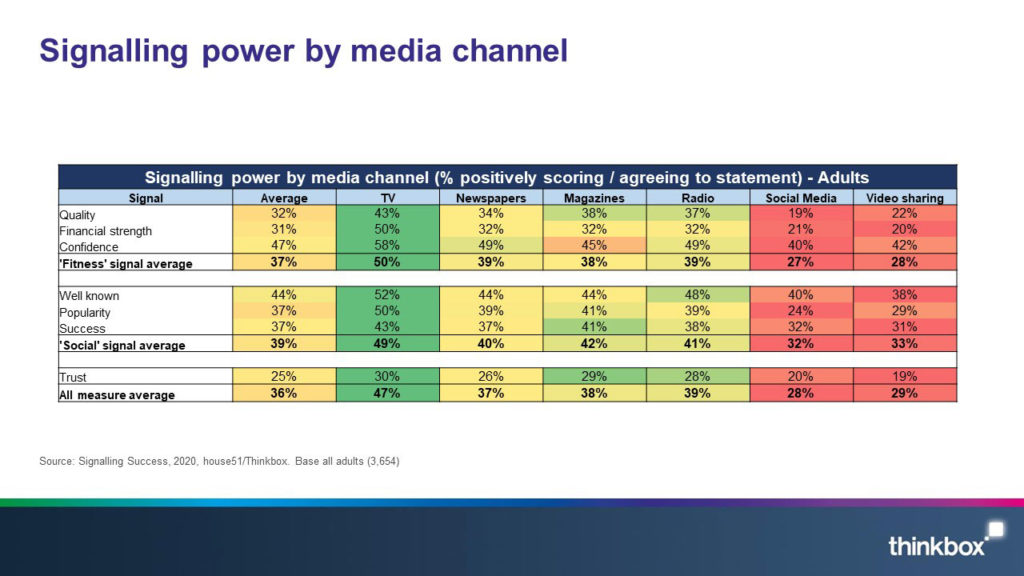• TV consistently delivered the strongest signals across all categories and audiences
• Social media and video sharing sites performed significantly below average
• Advertising on TV will deliver double the perceived level of quality & popularity than advertising on social media
A new study released today finds that TV is the medium most likely to help brands appear high quality, successful and popular in the eyes of consumers.
‘Signalling Success’ was conducted by research agency house51, commissioned by Thinkbox. Its findings are based on a quantitative study of 3,600 people in the UK.
The study is the first-known UK research dedicated to the behavioural science principle of ‘signalling’, which has been widely discussed by academics and behavioural scientists, including Rory Sutherland. The theory suggests that the perceived cost and scale of an advertising campaign translates to improved brand attributes.
The research methodology took the form of an experimental design, inspired by US academic research from Duke and Stanford universities. Each respondent was presented with a description of a fictionalised brand in one of four product categories alongside a brief outline of its launch advertising campaign. The respondent was then asked to answer a series of perception statements in relation to this brand, based solely on its description and proposed launch campaign.
In each case, all information was identical except for the medium being used in the campaign. This allowed house51 to isolate the ‘signalling effect’ of the media channel used, as all other variables were identical for each respondent.
House51 split the perception statements into three groups based on the type of signal communicated.
• ‘Fitness’ signals cover the perceived brand quality, financial strength of the company and the company’s confidence in their brand.
• ‘Social’ signals cover the brand’s perceived fame, popularity and success.
• Trust covers the perceived degree to which the brand will deliver against the promises it makes within its advertising.
Key findings from ‘Signalling Success’
When participants were told that the ad campaign would run on TV, their perception scores for ‘fitness’ signals were significantly higher than average.
• 50% of respondents rated brands that advertised on TV as financially strong. The next best performing advertising channels at signalling financial strength were newspapers, magazines and radio, all at 32%.
• Brands advertising on video sharing sites and social media consistently scored below average in ‘fitness’ signals. Only 19% perceived brands advertising on social media as ‘high quality’. This compared with video sharing sites at 22% and the top performing medium, TV, at 43%.
TV advertising helps brands to be perceived as more popular and successful.
• 43% rated brands advertising on TV as being successful, slightly ahead of magazines at 41%. Social media and video sharing sites are least likely to signal brand success at 32% and 31% respectively.
• TV, magazine and press advertising all help signal brand popularity. 50% of respondents rated TV advertising as demonstrating that lots of people were buying the brand, compared with 24% for social media and 29% for video sharing sites.
Brands advertising on TV, magazines and radio are perceived as most trusted to deliver on promises made.
• 30% rated brands advertising on TV as trusted to deliver on promises made, making TV the most trustworthy medium, just ahead of magazines (29%) and radio (28%).
• Advertising on video sharing sites was least likely to deliver brand trust at 19%.
The perception scores varied across brand categories and age groups, but TV consistently delivered the most powerful signals.
• TV drives the strongest ‘fitness’ and ‘social’ signals for online retail, FMCG, mobile phone networks and home insurance.
• Social media and video sharing sites were the advertising channels least likely to drive ‘social’ or ‘fitness’ signals in any of the categories tested.
• Younger audiences had a more positive perception of social media and video sharing sites at driving ‘social’ signals than older age groups. 32% of 16-34 year olds rated brands advertising on social media as popular, versus 23% for 35-54 year olds, and 18% for 55+. For all these audiences, TV signalled the highest brand popularity at 57% (16-34), 52% (35-54) and 42% (55+).
Results overview

Implications for advertisers
These findings show that the medium is indeed the message. Advertisers need to factor in the relative ability of channels to deliver on these crucial signals, which have such a significant effect on brand perception and message communication.
Newer brands, with low levels of awareness, in particular need to pay attention to this study. They are yet to form their own reputation, and so need to borrow their brand credentials from the advertising environment.
Matt Hill, Research & Planning Director at Thinkbox:
“The ‘as seen on TV’ effect is a widely used phrase to describe the ability of TV to deliver positive brand signals; if you’re advertising on TV, then you must be a high quality, widely used and trustworthy brand. This simple, but powerful study from house 51 finally provides concrete evidence of the superior signalling ability of TV and offers a huge amount of depth to our understanding of how signalling works across different media channels, categories and audiences.”
Catherine Heaney, Co-founder and partner, house51:
“This has been a fascinating project to work on and we are delighted that our research has reinforced and expanded the literature on advertising signalling. The power is in the scale and subtlety of our design. Across 24 controlled experiments and 3,600 interviews we only varied the proposed media channel. This allowed us to prove that ‘as seen on TV’ provides stronger signals of brand fitness, quality and trust and that the effect is consistent across product categories and audience demographics.”
Rory Sutherland, Vice Chairman of Ogilvy UK and author of Alchemy: The Surprising Power of Ideas That Don’t Make Sense:
“Evolutionary biologists have known this for years. But this is further proof that there is a hidden trade-off between efficiency and effectiveness. The perceived size of audience and the perceived cost of signalling significantly add to the signaller's power to convince.”
Source: thinkbox.tv

